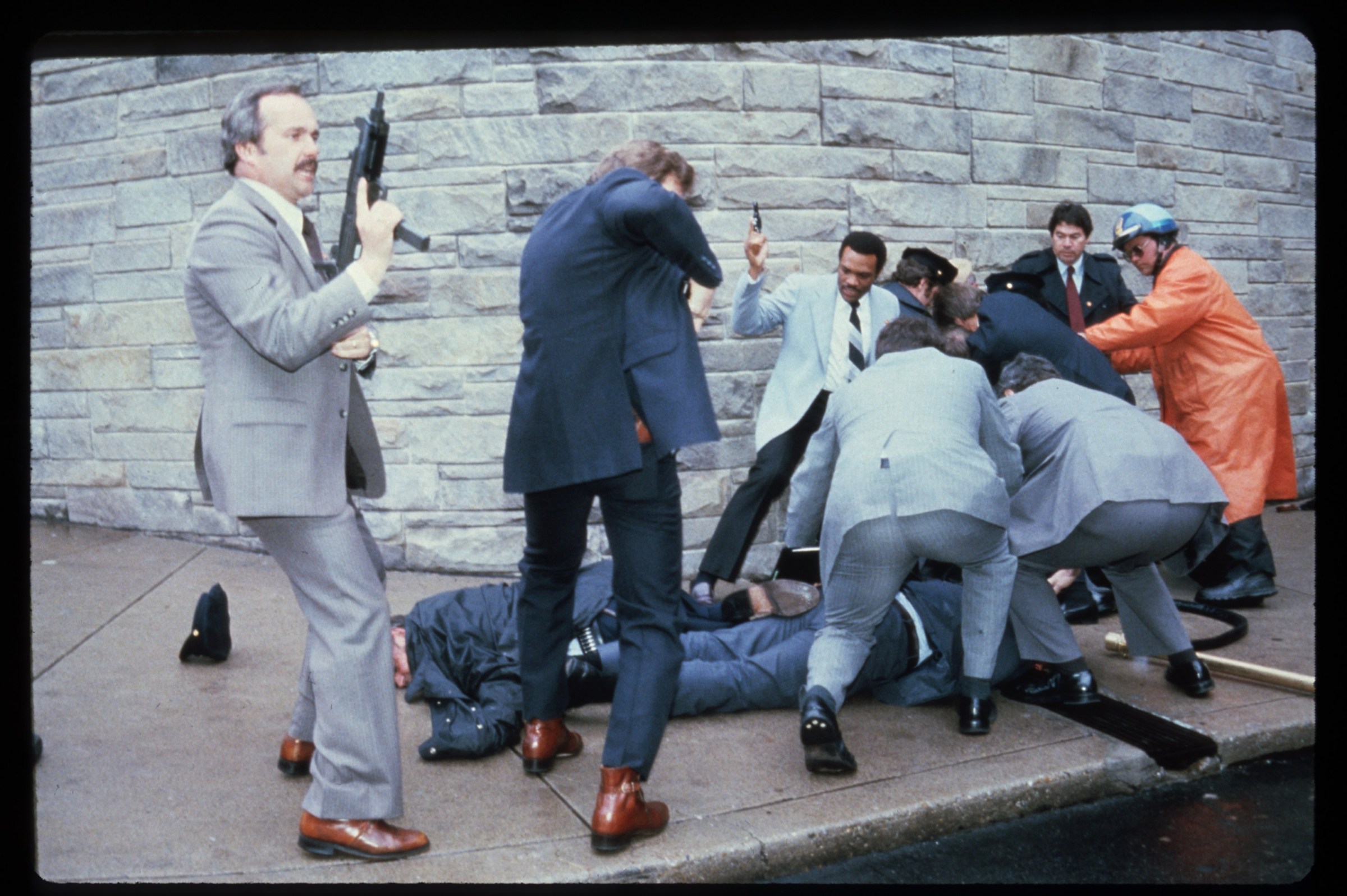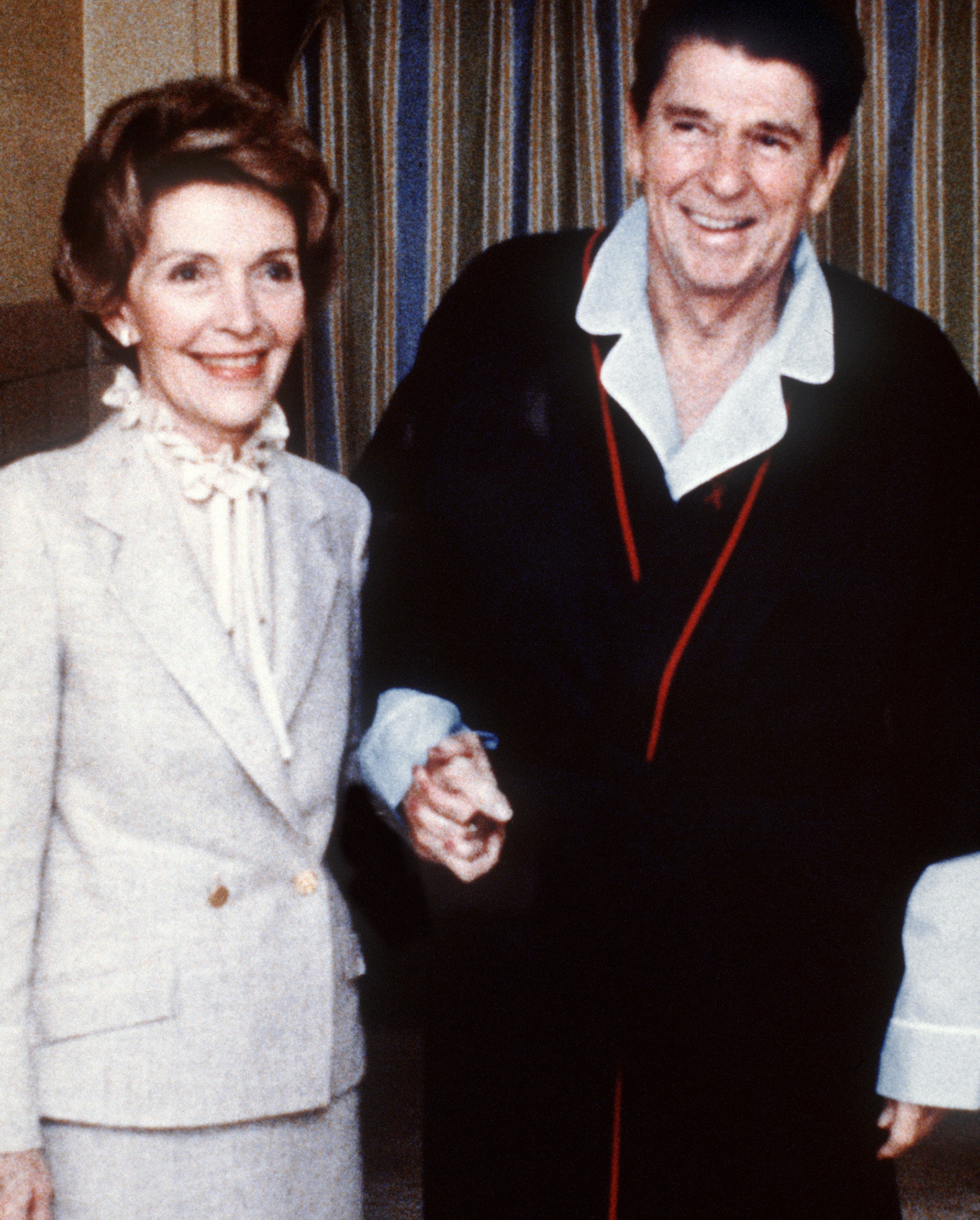Former President Donald Trump is the ninth US president to be a target of an assassination attempt. The last was President Ronald Reagan, who, like Trump, survived an attack by a lone shooter. But that was in 1981 — a decidedly different political moment than today’s highly polarized environment. And that means it’s uncertain that the political benefits Reagan saw after surviving his attempt will come to Trump.
On March 30, 1981, Reagan was exiting the Hilton Hotel in Washington, DC, where he had just given a speech before members of the AFL-CIO. As he raised his arm to salute the crowd gathered outside, six shots were fired toward him. President Reagan and three others were hit, including press secretary James Brady, who was left disabled. The bullet that hit Reagan narrowly missed his heart, but struck his rib, leading to a punctured lung. Reagan was rushed to the hospital, and emergency surgery saved his life.
The shooter was John Hinckley Jr., who was later found not guilty of attempted murder on account of insanity. He had no political motive: he had become obsessed with the actress Jodie Foster and thought he could impress her by shooting the president, just 18 years after President John F. Kennedy had been assassinated.
Chaos surrounds shooting victims immediately after the assassination attempt on President Reagan, outside the Hilton Hotel in Washington, DC.Dirck Halstead/Liaison/Getty Images
Chaos ensued in the immediate aftermath. While Reagan was incapacitated in surgery, there was a real question of who was running the country — and who controlled the nuclear arsenal at a time when Cold War tensions were at a near all-time high, in part because Reagan had entered office taking a tougher line on Moscow. Al Haig, Reagan’s secretary of state, erroneously claimed that he was in charge because Vice President George H.W. Bush was on his way back from Texas; under the Constitution’s succession clause, power passes to the speaker of the House after the president and vice president.
But once Reagan came through surgery and the immediate confusion disappated, the assassination attempt had a temporary unifying effect on the country. Reagan was able to project strength throughout the crisis and his recovery, solidifying his image as a leader for all Americans. That generated goodwill on both sides of the aisle and helped him advance key parts of his agenda in Congress.
Since the assassination attempt on Trump Saturday, there has been a similar outpouring of statements from public officials offering their well wishes for the former president and urging the country to come together to end political violence. But unlike in 1981, it’s unclear that much will change politically.
Both Reagan and Trump refused to be knocked down
Trump has sought to project strength in the aftermath of the assassination attempt.
After the shooter failed to hit him directly, Trump stood up amid the huddle of Secret Service agents encircling him to raise a fist in the air, blood dripping from his face, in a gesture of defiance.
On Sunday, he announced that he would not allow the assassination attempt to change his travel schedule for the Republican National Convention in Milwaukee which begins Monday.
Reagan similarly projected resilience after facing the attempt on his life.
Reagan walked into the hospital just after the shooting, despite having just coughed up blood in the limousine ride there. He cracked jokes that endeared him to the public: “Honey, I forgot to duck,” he told first lady Nancy Reagan. In his memoir An American Life, he recounted how he had told one of his doctors that he hoped they were a Republican, to which they replied, “Today, Mr. President, we’re all Republicans.”
Regardless of party affiliation, Americans rallied around him during his recovery. Four days after the assassination, he was captured smiling and standing up, clutching his wife’s hand, in a widely circulated photo from his time in the hospital. Upon his return home, he walked from the car to the White House residence to show how well he was doing.
Nancy Reagan and President Ronald Reagan as they smile and hold hands at George Washington University Hospital, four days after the president had been shot in an assassination attempt, in 1981.Mike Evens/AFP via Getty Images
“Wearing a bright red sweater over a white shirt, the president waved to the spectators and turned to walk into the White House, resembling, as an aide later put it, a ‘championship golfer strolling toward the eighteenth green,’” writes Del Quentin Wilber in his 2011 book about the assassination attempt, Rawhide Down.
1981 was a different time
Despite some parallels between Trump and Reagan’s responses to their attempted assassinations, Trump is operating in a totally different political environment.
Reagan had been catapulted to office in the 1980 election on a promise to “make America great again,” a slogan later adopted by Trump. It resonated at a time when many believed America’s best days were behind it amid high inflation, stagnant economic growth, the Iran hostage crisis, and rising Cold War tensions with the Soviet Union, which Reagan would go on to label an “evil empire.”
Though there were divides between Democrats and Republicans on many of these issues, it was nothing like the current environment in which identity politics reigns. Bipartisanship and moderates on both sides of the aisle were more common, and the media environment was more homogenous and far less around-the-clock than it is today. Though Reagan was a champion for socially conservative values, issues like abortion and immigration didn’t animate the same kind of tribalism in US politics. Reagan himself would go on to pass major immigration reforms in 1986 (something unthinkable in today’s divided Congress), and voter support for abortion didn’t fall neatly along party lines.
By mid-March of 1981, before the assassination attempt, Reagan was earning approval ratings as high as 60 percent. (Trump’s approval, on the other hand, is hovering around 42 percent.) But the assassination attempt and the way Reagan responded to it galvanized greater bipartisan support behind him and contributed to what ultimately became a hopeful national mood.
“On April 14, three days after I got home, the space shuttle Columbia returned to Earth in triumph after its maiden voyage,” Reagan wrote in his memoir. “The landing touched off tremendous excitement around the country, convincing me more than ever that Americans wanted to feel proud and patriotic again.”
Later that month, he delivered a televised address to a joint session of Congress — his first speech since the assassination attempt — in which he received repeated ovations from the crowd. He laid out an economic recovery plan that included major tax cuts and later passed despite Democratic opposition, acknowledging the “spirit of candor, openness, and mutual respect” that characterized the congressional negotiations.
“Thanks to some very fine people, my health is much improved. I’d like to be able to say that with regard to the health of the economy,” he said in the address.
By that May, Reagan’s approval rating had reached 68 percent. Though that did not last due to ongoing concerns about the economy, it was clear that Reagan had “turned a near tragedy into a political triumph,” Wilber writes.
Trump might hope to experience a similar political boost in the coming months. But it’s not clear how much more of an edge he can get in today’s hyperpartisan environment.
For Democrats, Trump still poses what they believe to be an existential threat to democracy in the November election. Trump’s Republican base believes that the former president needs their support now more than ever. And that means both parties are still on the same, ever more treacherous collision course.













![ROSE IN DA HOUSE I BE MY BOYFRIENDS 2 [OFFICIAL TRAILER]](https://cherumbu.com/wp-content/uploads/2022/01/ROSE-IN-DA-HOUSE-I-BE-MY-BOYFRIENDS-2-OFFICIAL-150x150.jpg)

